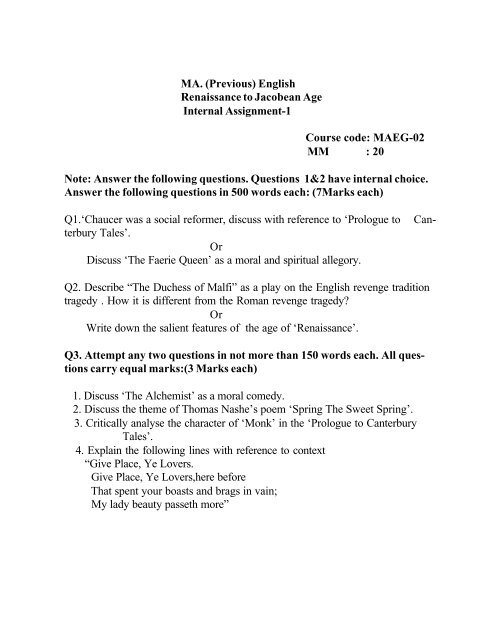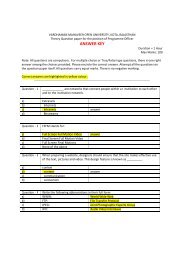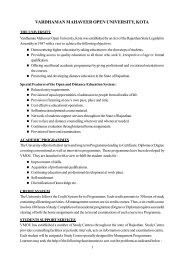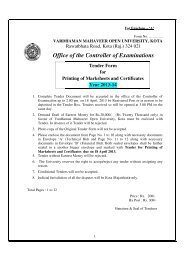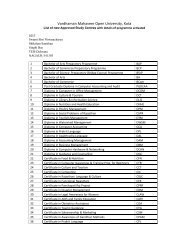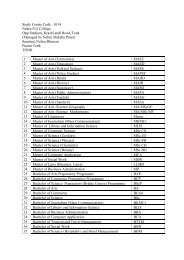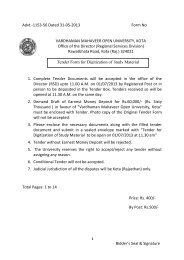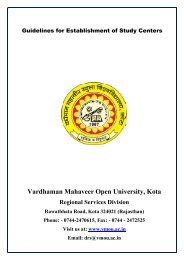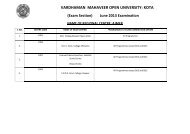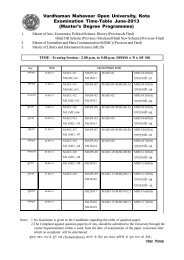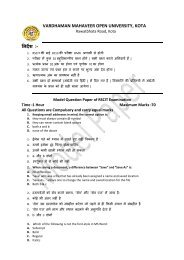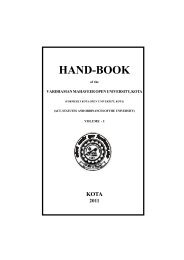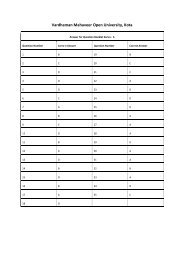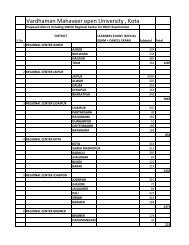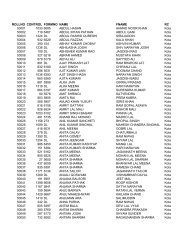MA. (Previous) English Renaissance to Jacobean Age ... - VMOU, Kota
MA. (Previous) English Renaissance to Jacobean Age ... - VMOU, Kota
MA. (Previous) English Renaissance to Jacobean Age ... - VMOU, Kota
Create successful ePaper yourself
Turn your PDF publications into a flip-book with our unique Google optimized e-Paper software.
<strong>MA</strong>. (<strong>Previous</strong>) <strong>English</strong><br />
<strong>Renaissance</strong> <strong>to</strong> <strong>Jacobean</strong> <strong>Age</strong><br />
Internal Assignment-1<br />
Course code: <strong>MA</strong>EG-02<br />
MM : 20<br />
Note: Answer the following questions. Questions 1&2 have internal choice.<br />
Answer the following questions in 500 words each: (7Marks each)<br />
Q1.‘Chaucer was a social reformer, discuss with reference <strong>to</strong> ‘Prologue <strong>to</strong> Canterbury<br />
Tales’.<br />
Or<br />
Discuss ‘The Faerie Queen’ as a moral and spiritual allegory.<br />
Q2. Describe “The Duchess of Malfi” as a play on the <strong>English</strong> revenge tradition<br />
tragedy . How it is different from the Roman revenge tragedy?<br />
Or<br />
Write down the salient features of the age of ‘<strong>Renaissance</strong>’.<br />
Q3. Attempt any two questions in not more than 150 words each. All questions<br />
carry equal marks:(3 Marks each)<br />
1. Discuss ‘The Alchemist’ as a moral comedy.<br />
2. Discuss the theme of Thomas Nashe’s poem ‘Spring The Sweet Spring’.<br />
3. Critically analyse the character of ‘Monk’ in the ‘Prologue <strong>to</strong> Canterbury<br />
Tales’.<br />
4. Explain the following lines with reference <strong>to</strong> context<br />
“Give Place, Ye Lovers.<br />
Give Place, Ye Lovers,here before<br />
That spent your boasts and brags in vain;<br />
My lady beauty passeth more”
<strong>MA</strong>. (<strong>Previous</strong>) <strong>English</strong><br />
<strong>Renaissance</strong> <strong>to</strong> <strong>Jacobean</strong> <strong>Age</strong><br />
Internal Assignment-2<br />
Course code: <strong>MA</strong>EG-02<br />
MM : 20<br />
Answer the following questions. Questions 1&2 have internal choice.<br />
Answer the following questions in 500 words each: (7Marks each)<br />
Q1. Discuss Marlowe’s ‘Dr. Faustus’ as a conflict between good and evil as two<br />
forces in the mind.<br />
Or<br />
Discuss the distinct style of Bacon’s writing on the basis of the essays ‘Of<br />
Truth’ and ‘Of Revenge’ prescribed in your course.<br />
Q2. Discuss Donne as a Religious Poet.<br />
Or<br />
What do you mean by Shakespearean tragedy? Discuss ‘King Lear’ as a tragedy.<br />
Q3. Attempt any two questions in not more than 150 words each. All questions<br />
carry equal marks:(3 Marks each)<br />
.<br />
1. What are the chief features of Shakespearean Comedy.<br />
2. Write a critical analysis of Donne’s poem ‘Cannonization’.<br />
3. What is <strong>Jacobean</strong> Poetry? What are it’s main features?<br />
4. Discuss the influence of <strong>Renaissance</strong> on the Elizabethan <strong>Age</strong>.
<strong>MA</strong>. (<strong>Previous</strong> )<strong>English</strong><br />
Caroline <strong>to</strong> Reformation <strong>Age</strong><br />
Internal Assignment-1<br />
Course code: <strong>MA</strong>EG-03<br />
MM : 20<br />
Answer the following questions. Questions 1&2 have internal choice.<br />
Answer the following questions in 500 words each: (7Marks each)<br />
Q1. What do you understand by ‘Pas<strong>to</strong>ral Elegy’? Discuss Mil<strong>to</strong>n’s ‘Lycidas’ as a<br />
Pas<strong>to</strong>ral Elegy.<br />
Or<br />
Attempt a character sketch of ‘Satan’ on the basis of the epic ‘Paradise Lost’-<br />
BookI&II.<br />
Q2.Write a critical appreciation of Andrew Marvell’s poem ‘To His Coy Mistress’.<br />
Or<br />
‘The Rape of the Lock’ is a masterpiece of satirical poetry. Discuss.<br />
Q3. Attempt any two questions in not more than 150 words each. All questions<br />
carry equal marks:(3 Marks each)<br />
1.Describe the significance of Spider and Bee episode in ‘The Battle of the<br />
Books’.<br />
2. Comment on the realism in ‘Tom Jones’.<br />
3. Write a critical summary of ‘To Daffodils’.<br />
4. Discuss the au<strong>to</strong>biographical element in ‘Paradise Lost’- Book I.
<strong>MA</strong>. (<strong>Previous</strong>) <strong>English</strong><br />
Caroline <strong>to</strong> Reformation <strong>Age</strong><br />
Internal Assignment-2<br />
Course code: <strong>MA</strong>EG-03<br />
MM : 20<br />
Answer the following questions. Questions 1&2 have internal choice.<br />
Answer the following questions in 500 words each: (7Marks each)<br />
Q1. John Dryden’s ‘Absolom and Achi<strong>to</strong>phel’ brings before us the political crisis<br />
of the age.<br />
Or<br />
Describe the significance of the title of Daniel Defoe’s ‘Moll Flanders’<br />
Q2. Write a critical appreciation of Collins’ ‘Ode <strong>to</strong> Simplicity’.<br />
Or<br />
What are the chief characteristics of the Res<strong>to</strong>ration <strong>Age</strong>?<br />
Q3. Attempt any two questions in not more than 150 words each. All questions<br />
carry equal marks:(3 Marks each)<br />
1. Write a note on the themes of the play ‘The School for Scandal’.<br />
2. What are the main features of Transitional Poetry?<br />
3. Discuss ‘The Progress of Poesy’ as a Pindaric ode.<br />
4. Write a critical appreciation of the poem ‘The Little Black Boy’.
<strong>MA</strong>. (<strong>Previous</strong>) <strong>English</strong><br />
The Romantic <strong>Age</strong><br />
Internal Assignment-1<br />
Course code: <strong>MA</strong>EG-04<br />
MM : 20<br />
Answer the following questions. Questions 1&2 have internal choice.<br />
Answer the following questions in 500 words each: (7Marks each)<br />
Q1. Discuss William Wordsworth as a Romantic poet.<br />
Or<br />
Comment upon the nature imagery in ‘The Rime of the Ancient Mariner’. How<br />
does nature help <strong>to</strong> arouse supernatural effect?<br />
Q2. Write an essay on the pic<strong>to</strong>rial quality of John Keats through his poems prescribed<br />
in your course.<br />
Or<br />
Examine Shelley’s ‘Adonais’ as an elegy.<br />
Q3. Attempt any two questions in not more than 150 words each. All questions<br />
carry equal marks:(3 Marks each)<br />
1. What do you mean by the term Hellenism? Do you find it in<br />
Keats’poetry? Give examples from his poetry <strong>to</strong> support your reasons.<br />
2. Write a summary of the poem ‘Kubla Khan’.<br />
3. What is the subject of thought in Wordsworth’s ‘Preface <strong>to</strong> Lyrical Ballads’?<br />
4. Explain the following lines with reference <strong>to</strong> the context.<br />
“Where are the songs of Spring?<br />
Ay, Where are they?<br />
Think not of them, thou hast thy music <strong>to</strong>o,<br />
While barred clouds bloom the soft dying day,<br />
And <strong>to</strong>uch the sutable plains with rosy hue;
<strong>MA</strong>.( <strong>Previous</strong>) <strong>English</strong><br />
The Romantic <strong>Age</strong><br />
Internal Assignment-2<br />
Course code: <strong>MA</strong>EG-04<br />
MM : 20<br />
Answer the following questions. Questions 1&2 have internal choice.<br />
Answer the following questions in 500 words each: (7Marks each)<br />
Q1. Write a note on Shelley’s treatment of nature in ‘Ode <strong>to</strong> the West Wind’ and<br />
‘Ode <strong>to</strong> The Skylark’.<br />
Or<br />
Discuss the theme , structure and significance of the title of Jane Austen’s<br />
‘Pride and Prejudice’.<br />
Q2. What do you understand by the term ‘Romanticism’? Write a brief note on the<br />
major poets of Romantic <strong>Age</strong>.<br />
Or<br />
Discuss the salient features of Hazlitt and Lamb as essayists.<br />
Q3. Attempt any two questions not more than 150 words each. All questions<br />
carry equal marks:(3 Marks each)<br />
1. What was theLord Byron’s purpose of writing ‘The Vision of Judgement’?<br />
2. Write down the summary of the novel ‘Ivanhoe’.<br />
3. Write a note on the use of myth and irony in Mary Shelley’s novel ‘Frankenstein’.<br />
4. What is the difference between Romantic poetry and Gothic novel?
<strong>MA</strong>.( Final) <strong>English</strong><br />
Principles of Criticism<br />
Internal Assignment-1<br />
Course code: <strong>MA</strong>EG-05<br />
MM : 20<br />
Answer the following questions. Questions 1&2 have internal choice.<br />
Answer the following questions in 500 words each: (7Marks each)<br />
Q1 Aris<strong>to</strong>tle’s ‘Poetics’ is a window <strong>to</strong> peep through the world of criticism’. Illuminate.<br />
Or<br />
Write a detailed note on the classification of ‘Vakrokti’.<br />
Q2. Discuss in detail the central idea of the poem ‘An Essay on Man’.<br />
Or<br />
Discuss T.S.Eliot as a critic. Support your answer with illustrations from ‘Tradition<br />
and Individual Talent’.<br />
Q3. Attempt any two questions in not more than 150 words each. All questions<br />
carry equal marks:(3 Marks each)<br />
1.Consider the view that ‘Culture and Anarchy’ is an indictment of the<br />
Vic<strong>to</strong>- rian <strong>Age</strong>.<br />
2. Write a short note on the division of the contents of the ‘Natyashastra’.<br />
3. Why does Dr. Johnson defend Shakespeare’s tragi -comedies?<br />
4. Write a note on Leavis’s views on an ideal critic.
<strong>MA</strong>. (Final) <strong>English</strong><br />
Principles of Criticism<br />
Internal Assignment-2<br />
Course code: <strong>MA</strong>EG-05<br />
MM : 20<br />
Answer the following questions. Questions 1&2 have internal choice.<br />
Answer the following questions in 500 words each: (7Marks each)<br />
Q1. Elucidate Northrop Frye and his ideology of archetypal literary theory.<br />
Or<br />
Describe Elaine Showalter’s Feminist theory.<br />
Q2. Discuss Simone de Beauvoir as a pioneer of Twentieth Century Feminism.<br />
Or<br />
Anand regards art and literature “as the instruments of humanism”. Substantiate<br />
your views with examples from the text.<br />
Q3. Attempt any two questions in not more than 150 words each. All questions<br />
carry equal marks:(3 Marks each)<br />
1. Write a short note on the major theme of ‘Imaginary Homelands’.<br />
2. Describe in brief the three phases of feminist theory.<br />
3. Discuss Fyre as myth critic.<br />
4. Discuss the role of violence in decolonization.
<strong>MA</strong>. (Final) <strong>English</strong><br />
Vic<strong>to</strong>rian <strong>Age</strong><br />
Internal Assignment-1<br />
Course code: <strong>MA</strong>EG-06<br />
MM : 20<br />
Answer the following questions. Questions 1&2 have internal choice.<br />
Answer the following questions in 500 words each: (7Marks each)<br />
Q1. Make a comparative study of Tennyson’s and Browning’s poetry.<br />
Or<br />
Discuss Browning as a writer of Dramatic Monologues.<br />
Q2. Attempt a critical appreciation of ‘The Wind-Hover’ with special reference <strong>to</strong><br />
its theme ,imagery, diction and versification .<br />
Or<br />
Write a note on the classification of ‘Novel’.<br />
Q3. Attempt any two questions in not more than 150 words each. All questions<br />
carry equal marks:(3 Marks each)<br />
1. Comment upon Arnold’s treatment of the s<strong>to</strong>ry of ‘Sohrab and Rustam’.<br />
2. Write a note on the theme of the sonnets of Elizabeth Barret Browning.<br />
3. Write a short note on elegiac note in Arnold’s poetry.<br />
4. Critically evaluate the poem ‘The Lotus Eaters’.
<strong>MA</strong>. (Final) <strong>English</strong><br />
Vic<strong>to</strong>rian <strong>Age</strong><br />
Internal Assignment-1<br />
Course code: <strong>MA</strong>EG-06<br />
MM : 20<br />
Answer the following questions. Questions 1&2 have internal choice.<br />
Answer the following questions in 500 words each: (7Marks each)<br />
Q1. Describe in detail the symbolism in the novel ‘Wuthering Heights’.<br />
Or<br />
Comment on the title of Thackeray’s novel ‘Vanity Fair’.<br />
Q2. ‘The subjection of the women’ discusses various feministic aspects. Discuss.<br />
Or<br />
Give an account of the his<strong>to</strong>ry of <strong>English</strong> criticism in the Vic<strong>to</strong>rian Period<br />
with special reference <strong>to</strong> Walter Pater’s ‘Studies in the His<strong>to</strong>ry of the <strong>Renaissance</strong>’.<br />
Q3. Attempt any two questions in not more than 150 words each. All questions<br />
carry equal marks:(3 Marks each)<br />
1. ‘Treasure Island’ is a fascinating novel of the adventureous life of searching<br />
treasures. Elucidate in brief.<br />
2. Describe in brief Hardy’s ‘Art of plot construction’.<br />
3. ‘Great Expectations’ is a glimpse of Hardy’s own life.Discuss<br />
4. Write a critical summary of ‘The Hero as a Poet’.
<strong>MA</strong>. (Final) <strong>English</strong><br />
Twentieth Century Literature<br />
Internal Assignment-1<br />
Course code: <strong>MA</strong>EG-07<br />
MM : 20<br />
Answer the following questions. Questions 1&2 have internal choice.<br />
Answer the following questions in 500 words each: (7Marks each)<br />
Q1. Critically examine ‘The Waste Land’ as a “Fabric of Myth and Symbolism”.<br />
Or<br />
Do you agree that the social criticism and class war is the theme of ‘Look<br />
Back in Anger’? Substantiate your ideas.<br />
Q2. Comment on the theme and style of its presentation in ‘The Play Boy of the<br />
Western World’.<br />
Or<br />
Compare and contrast Auden’s ‘September 1st ,1939’ with Yeats’ ‘Nineteen<br />
Hundred Nineteen’.<br />
Q3. Attempt any two questions in not more than 150 words each. All questions<br />
carry equal marks:(3 Marks each)<br />
1. Discuss how ‘Sailing <strong>to</strong> Byzantium’ is a poem of opposites.<br />
2.Critically analyse the play ‘Waiting for Godot’.<br />
3. Write a critical appreciation of the poem ‘Fern Hill’.<br />
4. What is a fable? Discuss ‘Brave New World’ as a fable.
<strong>MA</strong>. (Final) <strong>English</strong><br />
Twentieth Century Literature<br />
Internal Assignment-2<br />
Course code: <strong>MA</strong>EG-07<br />
MM : 20<br />
Answer the following questions. Questions 1&2 have internal choice.<br />
Answer the following questions in 500 words each: (7Marks each)<br />
Q1. Consider ‘Sons and Lovers’ as a record of the contemporary social life.<br />
Or<br />
What are the main features of Huxley’s ‘Brave New World’.<br />
Q2. Give a critical analysis of the play ‘Waiting for Godot’.<br />
Or<br />
Elaborate flight and fall as the central theme of the novel ‘A Portrait of the<br />
Artist as a young man’.<br />
Q3. Attempt any two questions in not more than 150 words each. All questions<br />
carry equal marks:(3 Marks each)<br />
1. Comment on Paul -Clara relationship in D.H.Lawrence’s ‘Sons and<br />
Lovers’.<br />
2. Give a critical overview of Orwell’s essay ‘Shooting an Elephant’.<br />
3. Write a note on the use of symbols in Virginia Woolf’s ‘Mrs. Dalloway’.<br />
4. Write a note on Modern drama.
<strong>MA</strong>. (Final) <strong>English</strong><br />
Indian Writing in <strong>English</strong> and in Translation<br />
Internal Assignment-1<br />
Course code: <strong>MA</strong>EG-08<br />
MM : 20<br />
Answer the following questions. Question number 1&2 have internal choice.<br />
Answer the following questions in 500 words each: (7Marks each)<br />
Q1. Discuss briefly Tagore as a mystic poet. Illustrate your answer.<br />
Or<br />
What is an epic?. ‘Savitri’ is an epic. Discuss.<br />
Q2. Discuss in detail the main themes of Mulk Raj Anand’s ‘Un<strong>to</strong>uchable’.<br />
Or<br />
Critically analyse ‘The Guide’ as a picaresque Novel.<br />
Q3. Attempt any two questions in not more than 150 words each. All questions<br />
carry equal marks:(3 Marks each)<br />
1. Write a note on feminine sensibility presented by Kamla Das through her<br />
poetry.<br />
2. Write a note on the Indianness infused in Nissim Ezekiel’s poetry.<br />
3. What is the dominant theme of ‘Kanthapura’?<br />
4. Critically analyse Sarojini Naidu’s poem ‘Conquest’.
<strong>MA</strong>. (Final) <strong>English</strong><br />
Indian Writing in <strong>English</strong> and in Translation<br />
Internal Assignment-2<br />
Course code: <strong>MA</strong>EG-08<br />
MM : 20<br />
Answer the following questions. Questions 1&2 have internal choice.<br />
Answer the following questions in 500 words each: (7Marks each)<br />
Q1. Justify the title of the play ‘The Abhijnanshakuntalam’.<br />
Or<br />
Write a note on Au<strong>to</strong>biographical genre in Indira Goswami’s work.<br />
Q2.Discuss ‘Godaan’ as a Socio- Political document of colonial India in the early<br />
decades of the twentieth century.<br />
Or<br />
Discuss ‘Voices in the City’ as an epic narrating the present day situation in<br />
Calcutta.<br />
Q3. Attempt any two questions in not more than 150 words each. All questions<br />
carry equal marks:(3 Marks each)<br />
1. Write a brief note on caste as character in the novel ‘Samskaras’.<br />
2. Discuss the title of the play ‘Mrichhakatikam’.<br />
3. Discuss in detail the major theme of Dattani’s ‘Final Solution’.<br />
4. Write a short note on the major themes discussed of ‘Mother of 1084’.
<strong>MA</strong>. (Final) <strong>English</strong><br />
Post Colonial Literature<br />
Internal Assignment-1<br />
Course code: <strong>MA</strong>EG-09<br />
MM : 20<br />
Answer the following questions. Questions 1&2 have internal choice.<br />
Answer the following questions in 500 words each: (7Marks each)<br />
Q1. Critically analyse the themes and title of the novel ‘Ice-Candy-Man’.<br />
Or<br />
In ‘Things Fall Apart’ Achebe brings before us Igbo tradition in the character<br />
of the pro<strong>to</strong>gonist Okonkwo. Discuss<br />
Q2. Intezar Hussain’s ‘A Letter from India ‘ fictionalizes his<strong>to</strong>ry and his<strong>to</strong>ricizes<br />
fiction. Justify.<br />
Or<br />
Consider Judith Wright as a postcolonial poet on the basis of the poem prescribed<br />
in your course.<br />
.Q3. Attempt any two questions in not more than 150 words each. All questions<br />
carry equal marks:(3 Marks each)<br />
1. Describe R. Parthasharthy’s post colonial aspects of writings through his<br />
poem ‘Exile from Home Coming’.<br />
2. Write a note on the imagery used in ‘A Far Cry from Africa’ and ‘First<br />
Neighbours’.<br />
3. Explain in brief the three meanings of the term ‘Journey’ that emerge<br />
from the s<strong>to</strong>ry.<br />
4. What is the difference between standard <strong>English</strong> and <strong>English</strong>es?
<strong>MA</strong>. (Final) <strong>English</strong><br />
Post Colonial Literature<br />
Internal Assignment-2<br />
Course code: <strong>MA</strong>EG-09<br />
MM : 20<br />
Answer the following questions. Questions 1&2 have internal choice.<br />
Answer the following questions in 500 words each: (7Marks each)<br />
Q1. Describe in detail the Post Colonial features in Judith Wright’s poetry.<br />
Or<br />
Define the following terms:<br />
1. Postcolonialism 2. Post Structuralism<br />
3. Feminism 4. Canadian Post Structuralism<br />
Q2. Amitav Ghosh in his short essay ‘The Diaspora in India Culture’ distinguishes<br />
between Indian diaspora and diaspora of other countries. Discuss.<br />
Or<br />
Comment upon the significance of the title ‘India: A Wounded Civilization’<br />
Q3. Attempt any two questions in not more than 150 words each. All questions<br />
carry equal marks:(3 Marks each)<br />
1. Write a critical appreciation of the poem ‘I Thank you God’.<br />
2. Write a note on the Post colonial features of the poem ‘Indian Women’.<br />
3. What are the fears that confront the person in the poem ‘The Shapes of<br />
Fear’?<br />
4. What is Post Structural theory?
<strong>MA</strong>. (Final) <strong>English</strong><br />
American Literature<br />
Internal Assignment-1<br />
Course code: <strong>MA</strong>EG-10<br />
MM : 20<br />
Answer the following questions. Questions 1&2 have internal choice.<br />
Answer the following questions in 500 words each: (7Marks each)<br />
Q1. “Whitman is the poet of the body and the poet of the soul”. Elaborate<br />
Or<br />
Bring out the salient features of the poetry of Emily Dickinson, illustrating<br />
them from the poems you have read.<br />
Q2. Discuss ‘The Scarlet Letter’ as a psychological novel.<br />
Or<br />
Describe in detail humour and satire in ‘The Adventures of Huckleberry<br />
Finn’.<br />
Q3. Attempt any two questions in not more than 150 words each. All questions<br />
carry equal marks:(3 Marks each)<br />
1. Write a note on the contribution of O’Neil <strong>to</strong> American Drama.<br />
2. Discuss the theme and technique of the poems of Robert Frost you have<br />
studied.<br />
3. Write a note on Modern American Drama and Theatre.<br />
4. What is the significance of Baker in the s<strong>to</strong>ry of ‘A Small, Good Thing’.
<strong>MA</strong>. (Final)<strong>English</strong><br />
American Literature<br />
Internal Assignment-2<br />
Course code: <strong>MA</strong>EG-10<br />
MM : 20<br />
Answer the following questions. Questions 1&2 have internal choice.<br />
Answer the following questions in 500 words each: (7Marks each)<br />
Q1. Write a note on the themes and symbols in Tony Morrison’s ‘The Bluest Eye’.<br />
Or<br />
Write a note on the modern American society and commercialized outlook?<br />
Q2. Justify the title of the play ‘The Glass Menagerie’. What is its symbolic significance?<br />
Or<br />
The essay ‘The Over Soul’ is said <strong>to</strong> be the most detailed projection of Emerson’s<br />
faith. Discuss.<br />
Q3. Attempt any two questions in not more than 150 words each. All questions<br />
carry equal marks:(3 Marks each)<br />
1. What is the portrait of a true thinker and scholar drawn by the Emerson ?<br />
2. Write a note on the significance of motifs of season in ‘The Bluest Eye’.<br />
3. What is O’ Neil’s sphilosophy of life?<br />
4. Write a brief note on the beauty and style of Toni Morrison’s writings.
<strong>MA</strong>. (<strong>Previous</strong>) <strong>English</strong><br />
<strong>English</strong> Language Usage and Communication Skill<br />
Internal Assignment-1<br />
Course code: <strong>MA</strong>EG-1<br />
MM : 20<br />
Answer the following questions. Questions 1&2 have internal choice.<br />
(7Marks each)<br />
Q1. Read the following passage carefully and answer the questions that follow in<br />
your own words:<br />
Throughout the human his<strong>to</strong>ry the leading causes of death have been infection and<br />
trauma. Modern medicine has scored significant vic<strong>to</strong>ries against both, and the<br />
major causes of ill health and death are now the chronic degenerative diseases,<br />
such as coronary artery disease, arthritis, osteoporosis, alzheimer, muscular<br />
degeneration, cataract and cancer. These have a long latency period before the<br />
symp<strong>to</strong>ms appear and a diagnosis is made. It shows that the majority of apparently<br />
healthy people are pre-ill.But are these conditions inevitabely degenerative? A<br />
truly preventive medicine that focuses on the pre-ill, analysing the metabolic errors<br />
which lead <strong>to</strong> clinical illness, might be able <strong>to</strong> correct them before the first<br />
symp<strong>to</strong>m. Genetic risk fac<strong>to</strong>rs are known for all the chronic degenerative disease,<br />
and are important <strong>to</strong> the individuals who possess them. At the population level,<br />
however, migration studies confirm that these illnesses are linked for the most part<br />
<strong>to</strong> lifestyle fac<strong>to</strong>rs- exercise, smoking and nutrition. Nutrition is the easiest of these<br />
<strong>to</strong> change, and most versatile <strong>to</strong>ol for affecting the metabolic changes needed <strong>to</strong> till<br />
the balance away from disease.<br />
Many national surveys reveal that malnutrition is common in developed countries.<br />
This is not the calorie and micronutrient deficiency associated with developing<br />
nations (Type A malnutrition): But multiple micronutrient depletion, usually<br />
combined with calorific balance or excess (Type B malnutrition). Such as the<br />
essential fatty acids, xanthophylls and flavonoids are included in the surveys.<br />
Commonly ingested levels of these micronutrients seem <strong>to</strong> be far <strong>to</strong>o low in many<br />
developed countries.<br />
There is no considerable evidence that type B malnutrition is a major cause of<br />
chronic degenerative diseases. If this is the case, then it is logical <strong>to</strong> treat such<br />
diseases not with drugs but with multiple micronutrient repletion, or pharmaco<br />
nutrition. This can take the form of pills and capsules- nutraceuticals, or food<br />
formats known as Functional foods. This approach has been neglected hither<strong>to</strong><br />
because it is relatively unprofitable for drug companies-the products are hard <strong>to</strong><br />
patent-and it is a
strategy which does not sit easily with modern medical interventionism. Over the<br />
last hundred years, the drug industry has invested huge sums in developing a<br />
range of subtle and powerful drugs <strong>to</strong> treat the many diseases we are subject<br />
<strong>to</strong>.Medical training is couched in pharmaceutical terms and this approach has<br />
provided us with an exceptional range of therapeutic <strong>to</strong>ols in the treatment of<br />
disease and in acute medical medical emergencies.However , the pharmaceutical<br />
model has also created an unhealthy dependency culture, in which relatively few<br />
of us accept responsibility for maintaining our own health. Instead, we have<br />
handed over this responsibility <strong>to</strong> health professionals who know very little about<br />
health mantenance or disease prevention.<br />
One problem for supporters of this argument is the lack of the right kind<br />
evidence.We have a wealth of epidemiological data linking dietary fac<strong>to</strong>rs <strong>to</strong><br />
health profiles/disease risks, and a great deal of information on mechanism: how<br />
food fac<strong>to</strong>rs interact with biochemistry. But almost all intervention studies with<br />
micronutrients, with notable exception of the omega 3 fatty acids,have so far<br />
produced conflicting or negative results. In other words, our science appears <strong>to</strong><br />
have no predictive value. Does this invalidate the science? Or are we simply asking<br />
the wrong questions?<br />
Based on pharmaceutical thinking, most intervention studies have attempted <strong>to</strong><br />
measure the impact of a single micronutrient on the incidence of disease. The<br />
classical approach says that if you give a compound formula <strong>to</strong> test subjects and<br />
obtain positive results , you cannot know which ingredient is exerting the benefit,<br />
so you must test each ingredient individually. But in the field of nutrition, this<br />
does not work. Each intervention on its own will hardly make enough difference<br />
<strong>to</strong> be measured. The best therapeutic response must , therefore, combine micronutrients<br />
<strong>to</strong> normalise our internal physiology. So do we need <strong>to</strong> analyse each<br />
individual’s nutritional status and then tailor a formula specifically for him or her?<br />
While we do not have the resources <strong>to</strong> analyse millions of individual cases, there<br />
is no need <strong>to</strong> do so. The vast majority of people are consuming suboptimal<br />
amounts of most micronutrients, and most of the micronutrients concerned are<br />
very safe. Accordingly, a comprehensive and universal program of micronutrient<br />
support is probably the most cost-effective and safest way of improving the general<br />
health of the nation.<br />
1. Why tailoring micronutrient- based treatment plans is not necessary <strong>to</strong> suit<br />
indivudual deficiency profiles? (2)<br />
2. Why does the author recommends micronutrient-repletion for large-scale treatment<br />
of chronic degenerative diseases? (2)<br />
3. Why are large number of apparently healthy people deemed pre-ill?(2)<br />
4. Why the Type-B malnutrition is a serious concern in developed countries?<br />
(1)
Write notes in 250 words each with suitable examples on the following:<br />
OR<br />
1. Compounding 2. Morphology<br />
Q2. You are Sagar . You visited an Educational exhibition at Pragati Maidan,<br />
New Delhi. Write a report giving a detail account of different stalls you visited.<br />
Q3. Attempt any two questions . All questions carry equal marks:(3 Marks<br />
each)<br />
1. Make one sentence each on the the following sentence patterns and label<br />
them SVOCA:<br />
1. SVO 2. AVOCA 3. SVAA 4. SVOA 5. SVOO<br />
6. SVC 7. SVAC 8. SVA 9. SVOC 10. SV<br />
2.. Change the following sentences in<strong>to</strong> passive voice:<br />
a) People eat rice all over the world. b). May you live long.<br />
c) He hopes <strong>to</strong> win a prize. d) Thank God.<br />
e) One must endure what one cannot cure.<br />
OR<br />
What is the difference between inflectional and derivational affixes? Give examples<br />
<strong>to</strong> illustrate your answer.<br />
3. Rewrite the following sentences by using verbs given in brackets:<br />
a) When we (take) our exams, we’ll have a holiday.<br />
b) Only one wearer( know) where the shoe (pinch).
<strong>MA</strong>. (<strong>Previous</strong>)<strong>English</strong><br />
<strong>English</strong> Language Usage and Communication Skill<br />
Internal Assignment-2<br />
Course code: <strong>MA</strong>EG-1<br />
MM : 20<br />
Note:Answer the following questions. Questions 1&2 have internal choice.<br />
(7Marks each)<br />
Q1. Write notes on the following:<br />
1. Voice Mail 2. Teleconferencing 3. E-Mail<br />
4. Instant Messaging 5. Website<br />
Or<br />
Define Business Communication. What are the main features of Business<br />
Communication.(500 words)<br />
Q2. Convey the following notions /concepts through a sentence each of your<br />
own.<br />
1. Advice 2. Suggestion 3. Probability<br />
4. Consequence 5. Prediction<br />
Or<br />
Correct the following sentences:<br />
1. The horse and the carriage are at the gate.<br />
2. Not only you but also I are <strong>to</strong> blame.<br />
3. Ram’s spectacles is very costly.<br />
4. It is you who is <strong>to</strong> blame for this.<br />
5. Many people lives in slums.<br />
Q3. Attempt any two questions in not more than 150 words each. All questions<br />
carry equal marks:(3 Marks each)<br />
1. Elaborate one of the following themes in the form of a composition.<br />
a) Terrorism a curse for humanity<br />
b) Increasing population affects environment.<br />
2. Define the following:<br />
a) Affixes<br />
b) Encoding and Decoding<br />
3. What is report? What is the meaning and purpose of writing a report?
Post Graduate Degree Programme<br />
LukrdksÙkj mikf/k dk;ZØe<br />
M.A..(<strong>Previous</strong>) <strong>English</strong><br />
,e-,- ¼iwokZ)½ vaxzsth<br />
Home Assignment for Internal Evaluation<br />
vkrafjd ewY;kadu gsrq l=h; ¼x`g½ dk;Z<br />
<strong>MA</strong>EG-01 <strong>to</strong> <strong>MA</strong>EG-04<br />
Department of <strong>English</strong><br />
¼vaxzsth foHkkx½<br />
Submit 45 days before your Term-end examination<br />
l=kad ijh{kk dh frfFk ls 45 fnu ekg iwoZ tek djok,a<br />
l= % 2010&2011<br />
Vardhaman Mahaveer Open University<br />
Rawatbhata Road, <strong>Kota</strong> (Raj.)<br />
o/kZeku egkohj [kqyk fo”ofo|ky;<br />
jkorHkkVk jksM+ dksVk ¼jktLFkku½ 324021
SSSs<br />
o/kZeku egkohj [kqyk fo”ofo|ky;<br />
LukrdksÙkj mikf/k dk;ZØe<br />
,e-,- ¼iwok)Z½ vaxzsth<br />
vkUrfjd ewY;kadu gsrq l=h; dk;Z <strong>MA</strong> EG-01 <strong>to</strong> <strong>MA</strong>EG-04<br />
fiz; Nk=]<br />
vkidks ,e,bth- 01 ls ,e,bZth- 04 rd ikB~;Øe ds fofHkUu iz”u i=ksa ds l=h; dk;Z fHk<strong>to</strong>k;s tk jgs gSa] ftudk<br />
fooj.k fuEu izdkj gS %&<br />
ikB~;Øe dksM+ iz”u i= dk uke<br />
<strong>MA</strong>EG-01 <strong>English</strong> Language Usage and Communication Skill<br />
<strong>MA</strong>EG-02 <strong>Renaissance</strong> <strong>to</strong> <strong>Jacobean</strong> <strong>Age</strong><br />
<strong>MA</strong>EG-03 Caroline <strong>to</strong> Reformation <strong>Age</strong><br />
<strong>MA</strong>EG-04 The Romantic <strong>Age</strong><br />
vkids iz”u^i= esa vkidks l=h; dk;Z djus gaSSA bUgs iwjk djds vki vfUre frfFk ls iwoZ vius {ks=h; dsUnz ds<br />
funs”kd ds ikl Lo;a mifLFkr gksdj vFkok iathd`r Mkd ls vo”; fHk<strong>to</strong>k nsaA izR;sd l=h; dk;Z 20 vad dk gSA<br />
nks Js’B iz”uksa ds mÙkjksa ds izkIrkad vkidh l=kad ijh{kk ds lkFk tksMs+ tk;saxsA l=h; dk;Z Lo;a dh gLrfyfi esa<br />
djasA rF;kRed =qfV;ksa dks NksM+ dj l=h; dk;ksZa dk iqueZwY;kad ugha gksrk gS] vkSj u gh bUgs lq/kkjus gsrq nqckjk<br />
Lohdkj fd;k tkrk gSaA vr% igyh ckj esa gh loZJs’B mÙkj fy[ksaA izR;sd iz”u&i= ds l=h; dk;Z vyx&vyx<br />
QkbZy esa uRFkh djsaA<br />
fo|kFkhZ izFke i`’B ij fuEu lwpuk vfdar djsaA<br />
M.A.<strong>English</strong> Programme(<strong>Previous</strong>)<br />
Scholar number.-----------------------------------<br />
Name of the Student:_____________________ Assignment number:_________________<br />
Father’s name : ------------------------------ Code of Programme: -------------------<br />
Address :------------------------------------<br />
----------------------------------<br />
- -----------------------------------<br />
-<br />
Name of programme :----------------------<br />
Name of study centre:-------------------- Name of regional centre: ----------------<br />
Last date of deposit of Int. Assignment :-----------------------------------------------------------
Post Graduate Degree Programme<br />
LukrdksÙkj mikf/k dk;ZØe<br />
M.A..(Final) <strong>English</strong><br />
,e-,- ¼mÙkjk)Z½ vaxzsth<br />
Home Assignment for Internal Evaluation<br />
vkrafjd ewY;kadu gsrq l=h; ¼x`g½ dk;Z<br />
<strong>MA</strong>EG-05 <strong>to</strong> <strong>MA</strong>EG-10<br />
Department of <strong>English</strong><br />
¼vaxzsth foHkkx½<br />
Submit 45 days before your Term-end examination<br />
l=kad ijh{kk dh frfFk ls 45 fnu ekg iwoZ tek djok,a<br />
l= % 2010&2011<br />
Vardhaman Mahaveer Open University<br />
Rawatbhata Road, <strong>Kota</strong> (Raj.)<br />
o/kZeku egkohj [kqyk fo”ofo|ky;<br />
jkorHkkVk jksM+ dksVk ¼jktLFkku½ 324021
o/kZeku egkohj [kqyk fo”ofo|ky;<br />
LukrdksÙkj mikf/k dk;ZØe<br />
,e-,- ¼mÙkjk)ZZ½ vaxzsth<br />
vkUrfjd ewY;kadu gsrq l=h; dk;Z <strong>MA</strong>EG-05 <strong>to</strong> EG-10<br />
fiz; Nk=]<br />
vkidks ,e,bZth- 05 ls ,e,bZth- 10 rd ikB~;Øe ds fofHkUu iz”u i=ksa ds l=h; dk;Z fHk<strong>to</strong>k;s tk jgs gSa] ftudk<br />
fooj.k fuEu izdkj gS %&<br />
ikB~;Øe dksM+ iz”u i= dk uke<br />
<strong>MA</strong>EG-05 Principles of Criticism<br />
<strong>MA</strong>EG-06 Vic<strong>to</strong>rian <strong>Age</strong> Literature<br />
<strong>MA</strong>EG-07 Twentieth Century Literature<br />
<strong>MA</strong>EG-08 Indian Writing in <strong>English</strong> and in Translation<br />
<strong>MA</strong>EG-09 Post Colonial Literature<br />
<strong>MA</strong>EG-10 American Literature<br />
vkids iz”u^i= esa vkidks l=h; dk;Z djus gaSSA bUgs iwjk djds vki vfUre frfFk ls iwoZ vius {ks=h; dsUnz ds funs”kd ds<br />
ikl Lo;a mifLFkr gksdj vFkok iathd`r Mkd ls vo”; fHk<strong>to</strong>k nsaA izR;sd l=h; dk;Z 20 vad dk gSA nks Js’B iz”uksa ds mÙkjksa<br />
ds izkIrkad vkidh l=kad ijh{kk ds lkFk tksMs+ tk;saxsA l=h; dk;Z Lo;a dh gLrfyfi esa djasA rF;kRed =qfV;ksa dks NksM+ dj<br />
l=h; dk;ksZa dk iqueZwY;kad ugha gksrk gS] vkSj u gh bUgs lq/kkjus gsrq nqckjk Lohdkj fd;k tkrk gSaA vr% igyh ckj esa gh<br />
loZJs’B mÙkj fy[ksaA izR;sd iz”u&i= ds l=h; dk;Z vyx&vyx QkbZy esa uRFkh djsaA<br />
fo|kFkhZ izFke i`’B ij fuEu lwpuk vfdar djsaA<br />
s<br />
LukrkdksÙkj mikf/k dk;ZØe ¼vaaxzsth½<br />
¼,e,- mÙkjk)Z½<br />
Scholar number: -------------------------------------------------------------------------------<br />
Name of student:----------------------------Assignment no.------------------------------------<br />
Father’s name--------------------------------Programme code----------------------------------<br />
Address-----------------------------------------------------------------------------------------------<br />
--------------------------------------------------------------------------------------------------------<br />
Name of programme:----------------------------Date of submission:-------------------------<br />
Name of regional centre-------------------------Study centre--------------------------------


